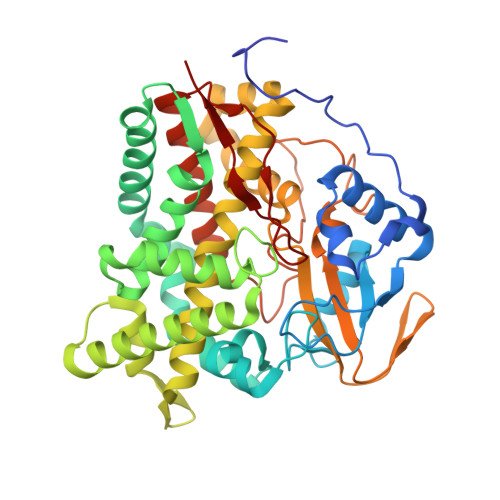Hydroxylation of Antitubercular Drug Candidate, SQ109, by Mycobacterial Cytochrome P450.
Bukhdruker, S., Varaksa, T., Grabovec, I., Marin, E., Shabunya, P., Kadukova, M., Grudinin, S., Kavaleuski, A., Gusach, A., Gilep, A., Borshchevskiy, V., Strushkevich, N.(2020) Int J Mol Sci 21
- PubMed: 33081390
- DOI: https://doi.org/10.3390/ijms21207683
- Primary Citation of Related Structures:
6T0J - PubMed Abstract:
Spreading of the multidrug-resistant (MDR) strains of the one of the most harmful pathogen Mycobacterium tuberculosis (Mtb) generates the need for new effective drugs. SQ109 showed activity against resistant Mtb and already advanced to Phase II/III clinical trials. Fast SQ109 degradation is attributed to the human liver Cytochrome P450s (CYPs). However, no information is available about interactions of the drug with Mtb CYPs. Here, we show that Mtb CYP124, previously assigned as a methyl-branched lipid monooxygenase, binds and hydroxylates SQ109 in vitro. A 1.25 Å-resolution crystal structure of the CYP124-SQ109 complex unambiguously shows two conformations of the drug, both positioned for hydroxylation of the ω-methyl group in the trans position. The hydroxylated SQ109 presumably forms stabilizing H-bonds with its target, Mycobacterial membrane protein Large 3 (MmpL3). We anticipate that Mtb CYPs could function as analogs of drug-metabolizing human CYPs affecting pharmacokinetics and pharmacodynamics of antitubercular (anti-TB) drugs.
- Research Center for Molecular Mechanisms of Aging and Age-Related Diseases, Moscow Institute of Physics and Technology, 141701 Dolgoprudny, Russia.
Organizational Affiliation:






















